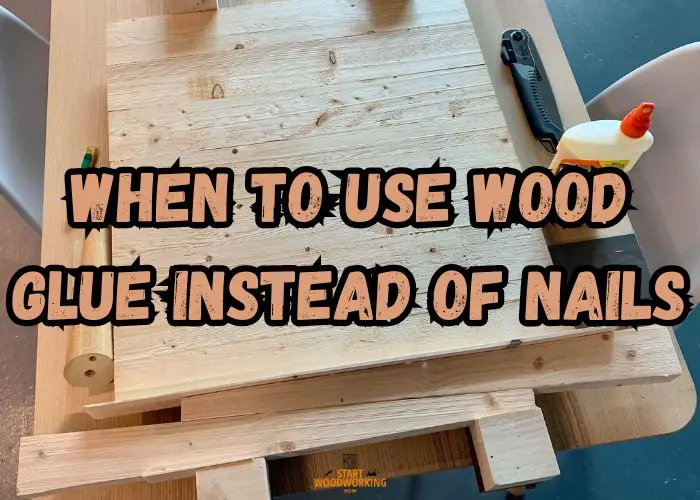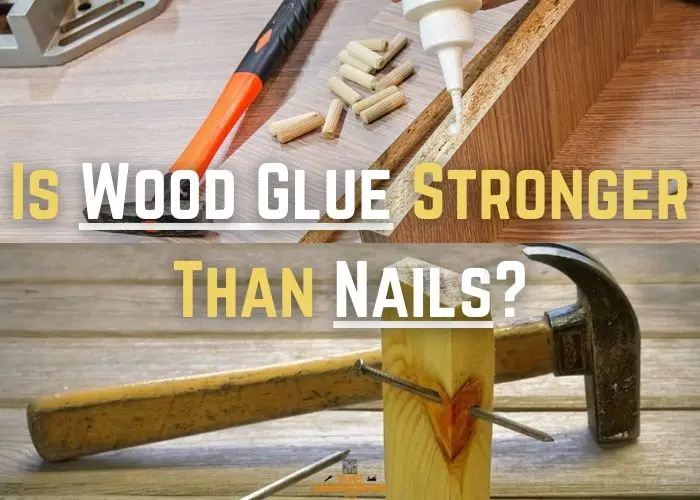Is Wood Glue Stronger Than Nails? Which One Should You Use?
If you’re a woodworker, you’ve probably asked yourself at some point whether wood glue is stronger than nails. As a woodworking hobbyist, I want to make sure the projects I build are durable and will withstand the test of time. When joining wood pieces together, I need to understand which fastening method – wood glue or nails – will provide the strongest bond.
Yes, wood glue is often stronger than nails. While nails provide immediate holding power, the bond created by wood glue is generally stronger in the long run. Wood glue penetrates the wood fibers, bonding them chemically into a single unit. This creates a stronger joint than nails which only hold the wood together at small contact points.
Firstly, wood glue penetrates the wood fibers, creating a bond that is stronger than the wood itself, whereas nails only hold the wood together at the point of contact. Moreover, when using nails, the wood might split or crack, compromising the strength of the joint.
Secondly, wood glue distributes the stress across the entire joint, making it more durable and resistant to vibrations and movements. Nails, on the other hand, only provide a point of contact, which can become loose over time, leading to a weaker joint.
Lastly, wood glue is more versatile than nails, as it can be used for a wide range of woodworking projects, from small crafts to large furniture. Nails, on the other hand, are limited by their size and application, and might not be suitable for certain types of wood or projects.
In conclusion, although nails have their place in woodworking, wood glue is generally stronger and more reliable.
Comparing the Strength of Wood Glue and Nails in Various Woodworking Joints
When it comes to woodworking, one of the most common questions is whether wood glue or nails are stronger. To answer this question, an experiment was conducted to compare the strength of wood glue and nails in various woodworking joints.
In the experiment, different types of joints were created using both wood glue and nails. These joints included butt joints, lap joints, and miter joints. The strength of each joint was then tested using a force gauge.
| Joint Type | Wood Glue Strength | Nail Strength | Best Method |
|---|---|---|---|
| Edge Joint | Very Strong – Glue penetrates end grain | Strong – Resists pull-out forces but no reinforcement | Glue alone or glue with brads |
| Face Joint | Extremely Strong – Glue penetrates the entire joint | Weak – Nails have little surface area for holding | Glue alone |
| Corner Joint | Very Strong – Glue penetrates all surfaces | Moderate – Prone to joint pulling apart over time | Glue with brads for reinforcement |
| Lap Joint | Strong – Glue bonds faces together | Moderate – Nail shear strength but no reinforcement | Glue with brads |
| Mortise & Tenon | Weak – Offers little strength to the reinforced joint | Weak – Offers little strength to reinforced joint | Glue alone |
| Dovetail Joint | Incredibly Strong – Glue forms bond throughout | Weak – Nails add no strength to intricate joint | Glue alone |
| Outdoor Projects | Exceptionally Durable – Resists weathering | Prone to Rust/Corrosion over time | Glue alone or hot-dipped galvanized nails |
In summary, wood glue forms the strongest bond for most joints due to reinforcing fibers. Nails provide quick assembly but little reinforcement. Glue alone or with hot-dipped nails is best for strength and durability. Proper joint design is also important for maximum holding power.
When to Use Wood Glue Instead of Nails

Wood glue is an adhesive that is ideal for joining wood edges, faces, and laminating. It is a versatile and affordable adhesive that can be used for a variety of woodworking projects, from small crafts to large furniture pieces.
Here are some situations where you should consider using wood glue:
1. Permanent Bonds:
- Wood Glue: Opt for wood glue when you need a strong, permanent bond between two pieces of wood. Glue creates a cohesive connection, enhancing the overall strength of joints.
2. Joining Large Surface Areas:
- Wood Glue: For projects involving large surface areas, where nails might not provide sufficient coverage, wood glue is ideal. It ensures uniform adhesion across the entire joint.
3. Wood-to-Wood Bonding:
- Wood Glue: When joining similar types of wood, especially in projects where aesthetics are crucial, wood glue creates seamless connections without the interruption of visible nails.
4. Stress Distribution:
- Wood Glue: Choose wood glue when you want stress to be evenly distributed across the joint. Glue offers a continuous and uniform connection, reducing the risk of stress concentrations.
5. Increased Joint Strength:
- Wood Glue: For joints that require maximum strength, especially in load-bearing applications, wood glue provides superior adhesive properties, reinforcing the connection.
6. Creating Durable Wood Composites:
- Wood Glue: If your project involves laminating or creating wood composites, wood glue ensures a durable and long-lasting bond, resulting in a unified and stable structure.
7. Hidden Fastening:
- Wood Glue: When aiming for a clean and seamless finish without visible fasteners, wood glue is the preferred choice. It eliminates the need for nails, providing a sleek appearance.
8. Avoiding Surface Damage:
- Wood Glue: Opt for wood glue when you want to avoid surface damage caused by nails. This is particularly important when working with delicate or thin materials where nails may cause splitting.
9. Joining Hardwoods:
- Wood Glue: In projects involving hardwoods, where the density and hardness can pose challenges for nails, wood glue offers a reliable solution. It creates a strong bond even in dense wood.
10. Waterproofing:
- Wood Glue: When water resistance is a priority, as in outdoor projects or those exposed to moisture, choose waterproof wood glue. It provides a protective barrier against water infiltration.
11. Minimizing Visible Fasteners:
- Wood Glue: For a more polished and professional look, especially in fine woodworking, wood glue allows you to join pieces without the distraction of visible nails.
12. Fine Woodworking and Cabinetry:
- Wood Glue: In intricate projects like fine woodworking or cabinetry, where precision and aesthetics are paramount, wood glue ensures a clean and flawless finish.
When to Use Nails Instead of Wood Glue
Here are some situations where you should consider using nails:
1. Temporary Joints and Disassembly:
- Nails: Choose nails when creating joints that may need to be disassembled in the future. Nails provide a secure connection while allowing for easier separation compared to the permanent bond of wood glue.
2. Quick Assembly:
- Nails: Opt for nails when speed is a priority. They offer a faster assembly process, requiring minimal drying or curing time. This allows you to proceed with the next steps of your project without waiting for adhesives to set.
3. Visible Fastening:
- Nails: When a visible fastening method is acceptable or even desirable, nails are a good choice. Some projects may benefit from the aesthetic of exposed nails, adding a decorative or rustic touch.
4. Flexible Joints:
- Nails: If the joint needs to retain some level of flexibility, nails are preferable. Wood glue tends to create a rigid bond, while nails can allow for slight movement in the joined pieces.
5. Stress-Free Application:
- Nails: For less stressful application, especially for beginners, nails can be more forgiving. Unlike wood glue, nails provide an immediate and tangible connection, reducing the risk of misalignment during the assembly process.
6. Working with Hardwoods:
- Nails: In some cases, working with hardwoods may be challenging for wood glue due to their dense nature. Nails can provide a reliable alternative for securing joints in hardwood projects.
7. Outdoor Projects:
- Nails: For outdoor projects exposed to the elements, where waterproof characteristics are not a primary concern, nails can be a suitable choice. They may be less prone to deterioration in certain weather conditions compared to wood glue.
8. Avoiding Glue Stains:
- Nails: If you want to avoid potential glue stains on visible surfaces, especially on light-colored woods, nails provide a clean and stain-free fastening method.
9. Adjustable Joints:
- Nails: When adjustment or realignment of joints during or after assembly is necessary, nails are more forgiving. They allow for minor corrections without the need to break a glued bond.
10. Joining Different Materials:
- Nails: In projects involving the joining of wood with other materials, nails may provide a more versatile solution. They can secure diverse materials without the limitations of adhesive bonding.
Durability Comparison
Glue Bonds Withstand Elements Better While Nails Can Rust/Corrode
When it comes to durability, wood glue bonds are generally stronger than nails. Glue creates a tight bond between the two surfaces, making it less likely for the wood to separate or loosen over time. This is especially true when the wood is exposed to elements such as moisture, heat, or cold. Glue bonds are more resistant to these elements than nails.
On the other hand, nails can rust or corrode over time, especially if they are exposed to moisture. This can weaken the bond between the wood and the nail, causing the wood to become loose or even fall apart. In addition, nails can create small holes in the wood, which can allow moisture to seep in and cause rotting.
Applications Like Outdoor Furniture
For outdoor furniture, wood glue is a better choice than nails. Glue bonds are more resistant to moisture, which is essential for outdoor furniture that is exposed to rain, snow, and humidity. Glue bonds are also less likely to loosen over time due to temperature changes, which can cause the wood to expand and contract.
Nails, on the other hand, are more suitable for indoor furniture or projects that do not require as much durability. Nails are easier to use and can be more convenient for projects that require quick assembly. However, nails may not provide the same level of strength and durability as glue bonds.
Conclusion
When deciding between nails and wood glue, you need to consider the specific project you’re working on. If you’re building something that requires a lot of strength, such as a chair or a table, wood glue is likely your best option.
It creates a much stronger bond than nails and can withstand the weight and pressure of heavy use. However, if you’re working on a smaller project that doesn’t require as much strength, nails may be sufficient. They’re also a good option if you need to join pieces of wood quickly and don’t have time to wait for glue to dry.
In summary, when it comes to durability, wood glue bonds are generally stronger than nails. Glue bonds are more resistant to elements such as moisture, heat, or cold. Glue bonds are less likely to loosen over time, making them a better choice for outdoor furniture. Nails are more suitable for indoor furniture or quick assembly projects that do not require as much durability.
Frequently Asked Questions
Wood glue forms stronger, more water-resistant bonds and is generally more suitable for outdoor projects where moisture is a factor.
Hardwoods like oak benefit more from glue, while softwoods like pine can be joined securely with either. Glue prevents splitting in hardwoods.
Glue joints are often twice as strong as nailed joints and can be stronger than the surrounding wood material when cured fully.
Yes, nails can be driven at angles through glued joints to help clamp the glue during curing and add extra holding power.





